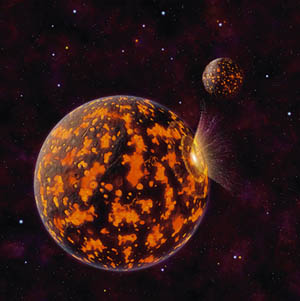Summary of Recent Talks
-
Tau-Herculids Meteor Shower and Comet Schwassmann-Wachmann 3, Jérémie Vaubaillon
-
Simultaneous Radar & Electro-optical Observations of Meteors, Rob Weryk
-
Phoenix Mars Lander 2007 Potential Landing Site, Jean-Baptiste Kikwaya
______________________________________________________
Tau-Herculids Meteor Shower and Comet Schwassmann-Wachmann 3
Jérémie Vaubaillon
Aug. 3, 2005

From August 7 through August 12, Jérémie will be attending the IAU symposium on asteroids, comets, and meteors. At this week's group meeting, he presented the talk he will be giving at the symposium. The abstract can be found here.
______________________________________________________
Barometers: An Overview
Andrew Weatherbee
July 27, 2005

A barometer is an instrument used to measure atmospheric pressure. A microbarometer measures changes in pressure from 0.1bar to 1mbar and is classified into two types: absolute and differential. An absolute microbarograph measures an absolute change in pressure relative to a backing volume. A differential microbarograph on the other hand, measures the change between two volumes. This is the type used in our infrasound array.
______________________________________________________
Simultaneous Radar & Electro-optical Observations of Meteors
Rob Weryk
July 13, 2005

Rob's PhD thesis involves making simultaneous observations of meteors using radar and electro-optical data. The primary goal of the project is to be able to relate the visual magnitude of the meteor to the electron ionisation in its trail. A secondary goal is to be able to independently determine meteor mass from a radar head echo. Rob is using CMOR along with Generation III image intensified CCD cameras for his observations.
On the night of April 12, seventeen simultaneous meteors were detected, though the data has yet to be analyzed. The Perseid shower in August should also provide useful observations.
______________________________________________________
Phoenix Mars Lander 2007 Potential Landing Site
Jean-Baptiste Kikwaya
July 6, 2005

The Phoenix Mars Lander is scheduled to land in the north polar region of Mars in May, 2008. Once there, it will use a robotic arm to expose the upper few feet of the surface material and will attempt to find evidence of water. The actual landing site is still being determined, though it has been narrowed down to four possible areas. In searching for an appropriate site, the objective is to find a balance between potential scientific results and landing safety. The region explored in this talk has a number of interesting geological features that may indicate the presence of water, with smooth surfaces that will be safe to land on.
To determine the characteristics of a potential landing site, a number of imaging instruments are used such as THEMIS (Thermal Emission Imaging System, on Odyssey), MOLA (Mars Orbiter Laser Altimeter), and MOC (Mars Orbiter Camera). These instruments are in the process of providing more extensive coverage of the landing regions.
______________________________________________________
The Late Heavy Bombardment
Peter Brown
June 21, 2005

The period of Late Heavy Bombardment is thought to have occurred between 3.8 and 3.9 billion years ago, though there is still debate as to whether it actually happened. Evidence from the Apollo missions, such as the cratering density, the ages of moon rocks, and analysis of impact melts, does appear to indicate heavy activity around that time and suggests that it occurred over a period of 50 to 100 million years. The cratered uplands on Mars and Mercury as well as the Martian meteorite ALH84001 also seem to provide evidence for this. It is thought that the migration of the planets may have been a contributing factor to the cause of the bombardment. Gomes et al. (2005) have proposed that at one time, Jupiter and Saturn were in a 1:2 mean motion resonance with each other, ultimately scattering Neptune out of its orbit. In turn Neptune excited the planetesimals in the remnant formation disk, delivering that flux through the solar system.
A number of questions arise about the validity of the evidence and theories for the LHB, such as whether impact melts do reflect impact flux, and whether the timing of the Gomes model agrees. It is also interesting to note that life emerged not long after the bombardment would have finished.
______________________________________________________
Martian Meteors
Jérémie Vaubaillon
June 15, 2005

At twilight on March 7, 2004, the Mars Exploration Rover Spirit discovered what may be the first identified Martian meteor. In order to produce a meteor, an atmosphere and a comet are required. There about 34 known comets approaching Mars and about 32 possible meteor showers. The timing of the event captured by Spirit and the shape of its light curve indicate that the meteor may have come from the comet Wiseman-Skiff. The orbital elements of the comet appear to agree with this possibility, and a meteor shower from this comet was predicted to occur four days after Spirit's detection. It is very likely that the streak may indeed be a meteor that originated from Wisemann-Skiff. More information can be found in this Nature article.
Also from this web page:


